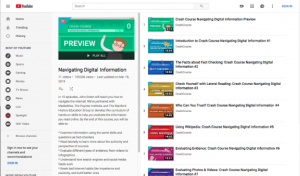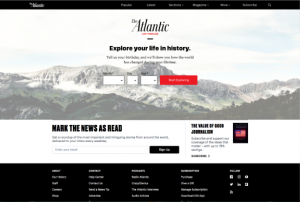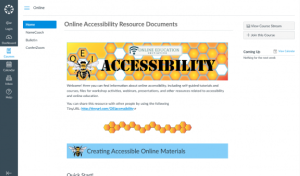Theme: World Art Day
Back to Top
|
 |
|
Hyperallergic
|
Arts |
|
Since its initial launch in late 2009, the independent digital magazine Hyperallergic has grown into an influential arts journalism platform, describing itself as "a forum for playful, serious, and radical perspectives on art and culture in the world today." Both arts professionals and those generally curious about art may enjoy this thought-provoking site, where visitors will find thousands of articles ranging from art news, visual and performing arts reviews, photo essays, in-depth features, interviews, and even comics and poetry. This dizzying array of content is accompanied by a well-organized menu and the site is also searchable. Those interested in more leisurely reads may want to check out Hyperallergic's weekend edition, which is comprised of eight weekly "thoughtful pieces about art, literature, film, music, and required reading links from around the web" and is also available as an email newsletter (among several options). Visitors may also like to check out their podcast, which launched in 2016. Based in Brooklyn, New York, Hyperallergic is run by its co-founders Hrag Vartanian, the editor-in-chief and art critic and his husband, publisher Veken Gueyikian. [JDC] |
|





|
|
 |
|
Italian Renaissance Learning Resources
|
Arts |
|
Italian Renaissance Learning Resources is a free web resource for students and teachers that was created through a collaboration between the U.S. National Gallery of Art and Oxford University Press's Grove Art Online. Italian Renaissance Learning Resources is organized into eight units that each explore a different theme in Italian Renaissance art. Within each unit are essays, primary sources, images of artwork, a glossary, questions for discussion, and activities with suggested academic levels: elementary, intermediate, or advanced. For example, the unit "Picturing Family and Friends" features essays and case studies on husbands and wives, children, lovers, and friends and enemies. The images in this unit include painted portraits as well as coins with representations of powerful people and their associates. The primary sources -- poems and descriptions of weddings -- are transcribed for the website, while the activities are things like designing a wedding cassone (a marriage chest). Other activities listed on the site include looking at the details of a dowry and comparing the Renaissance ideas of friendship with twenty-first-century ideas. [DS] |
|





|
|
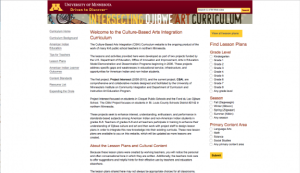 |
|
Intersecting Ojibwe Art Curriculum
|
Arts |
|
Elementary and middle school educators may want to check out this resource featuring classroom activities that integrate Ojibwe art and culture "to enhance interest, understanding, enthusiasm, and performance in standards-based subjects among American Indian and non-American Indian students in grades K-8." Here, visitors will find a large collection of standards-aligned, arts-integrated lesson plans developed by working teachers and organized by grade level, season, and primary content area. One example of a spring lesson that integrates art and science features birchbark birdhouses, which students make in class while learning about paper birch's significance to Native cultures in the Lake Superior region. This robust curriculum also includes tips for teachers, a list of additional resources, and a thorough explanation of its pedagogical philosophy, content standards, and intended learning outcomes. While these lessons are designed to be specific to Ojibwe culture, educators and tribal leaders in other regions may like to use this resource as a model for developing a similar curriculum that would be accurate and appropriate for their local Native cultures. Intersecting Ojibwe Art Curriculum is the result of Project Intersect and the Culture-Based Arts Integration Curriculum, two projects facilitated by the University of Minnesota and funded by the US Department of Education. [JDC] |
|





|
|
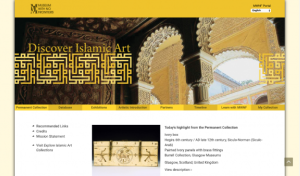 |
|
 |
|
National Museum of Australia: Harvest of Endurance
|
Arts |
|
First displayed in 1988, Harvest of Endurance is a scroll more than 160 feet (50 meters) long "that represents two centuries of Chinese contact with, and emigration to, Australia." This intricate artwork was hand-painted on 18 panels in the traditional gong bi style, which aims "to achieve harmony through balance and an application of the principles of yin and yang." Here, the National Museum of Australia enables visitors to view the entirety of this beautiful scroll online. In the explore the scroll section, visitors can navigate through the scroll's highly detailed sections and read the short accompanying texts explaining the scenes and history it depicts, with links to further information on specific people when relevant. Visitors may also choose to view the scroll without the explanatory text as an interactive virtual exhibit. Readers who are unfamiliar with this type of artwork may also want to read about how to read the scroll for some brief background information. Harvest of Endurance was conceived and researched by Mo Yimei, who at the time was a graduate student at Australian National University, and painted by her brother, Mo Xiangyi, and his wife, Wang Jingwen. [JDC] |
|





|
|

